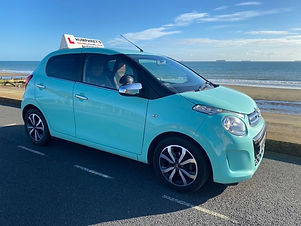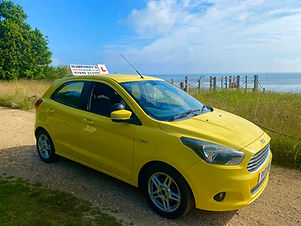Humphrey's
Driving Lessons

The Road to Your Licence: A Complete Guide to Driving Lessons
Learning to drive is an exciting milestone. It’s a rite of passage that represents freedom, independence, and a valuable life skill. But for a first-timer, the journey from applying for a provisional licence to tearing up your ‘L’ plates can seem complex and even a little daunting.
This guide will walk you through every step of the process, from finding the right instructor to what you can expect on your very first lesson and beyond.
Step 1: Before You Book a Lesson
Before you can even sit in the driver's seat, there are two essential prerequisites:
-
Get Your Provisional Licence: You cannot legally drive on public roads, even with an instructor, without a valid provisional driving licence. You can apply for one online via the GOV.UK website as long as you are at least 17 years and old and can read a number plate from 20 metres away.
-
Check Your Eyesight: The legal requirement is to be able to read a standard UK number plate from 20 metres. Your instructor will likely check this on your first lesson. If you need glasses or contact lenses to meet this standard, you must wear them every time you drive.
Step 2: Finding the Right Driving Instructor
Your instructor will be your guide, mentor, and coach. Finding someone you trust and feel comfortable with is crucial for your progress. Here are the key decisions to make:
Manual or Automatic?
-
Manual (Stick Shift): Passing your test in a manual car allows you to drive both manual and automatic vehicles. It gives you a greater sense of control and can be more engaging. Manual cars are also often cheaper to buy and maintain.
-
Automatic: Learning in an automatic is simpler as you don't have to worry about the clutch pedal and changing gears. This can reduce anxiety and may lead to passing your test faster. However, if you pass in an automatic, you are only licensed to drive automatic cars.
Independent Instructor or Driving School?
-
Driving Schools: Larger, often national schools offer structured lesson plans, online booking systems, and have a large pool of instructors available. They can sometimes offer good introductory discounts.
-
Independent Instructors: A local, independent instructor often provides a more personal, flexible service. Their reputation is built on word-of-mouth, so quality is usually high. You will be dealing with the same person for booking and lessons every time.
What to Look For:
-
Qualifications: Ensure they are an ADI (Approved Driving Instructor) and display a green badge in their windscreen. A pink badge indicates a PDI (Potential Driving Instructor) who is still in training.
-
Reviews and Recommendations: Look for genuine reviews online or ask friends and family for recommendations.
-
Cost and Lesson Duration: Prices vary by location. Lessons are typically 1, 1.5, or 2 hours long. A 2-hour lesson is often most effective as it allows you to get into the flow of driving without feeling rushed.
-
Personality: Try to have a quick chat with a potential instructor before booking. Do they sound patient and friendly? Feeling comfortable asking questions is essential.
Step 3: Your First Time Behind the Wheel
Your first lesson can be nerve-wracking, but instructors are experts at calming nerves. It will typically involve:
-
Paperwork: Your instructor will check your provisional licence and may ask you to sign their terms and conditions.
-
The Cockpit Drill: You'll learn the "DSSSM" routine: Doors, Seat, Steering, Seatbelt, and Mirrors. This is the fundamental setup you will do every single time you get in the car.
-
The Controls: You'll be introduced to the pedals, steering wheel, gearstick (if manual), and handbrake.
-
Moving Off and Stopping: In a quiet, safe location like an industrial estate or a quiet residential street, you'll learn the basic procedure for moving the car away from the kerb and bringing it to a safe stop.
Step 4: The Core Skills You'll Learn
As your lessons progress, you will build on the basics and cover a wide range of skills, including:
-
Junctions: Emerging and entering from T-junctions, crossroads, and slip roads.
-
Roundabouts: Approaching and navigating mini-roundabouts and larger, multi-lane roundabouts.
-
Manoeuvres: You will learn to master several key manoeuvres, such as parallel parking, bay parking (forwards and reverse), and pulling up on the right-hand side of the road.
-
Emergency Stops: Learning how to stop the car quickly and safely in an emergency.
-
Dual Carriageways: Driving safely at higher speeds, including overtaking and changing lanes.
-
Independent Driving: You will learn to follow directions from a sat-nav or from road signs to prepare you for this section of the practical test.
Step 5: The Theory Test
You must pass the UK Driving Theory Test before you can book your practical test. It consists of two parts:
-
Multiple-Choice Questions: 50 questions based on the Highway Code, traffic signs, and driving theory.
-
Hazard Perception: A series of video clips where you must click to identify developing hazards.
It's highly recommended to study for this alongside your practical lessons, as the theory directly applies to your real-world driving. There are many excellent apps and online resources to help you practice.
Step 6: Life After 'L' Plates
Passing your test is a fantastic achievement, but the learning doesn't stop. Consider taking the Pass Plus course, a government-backed scheme that involves six modules to improve your skills in areas not covered in the test, such as motorway and night driving. It can also lead to a discount on your car insurance.
Driving is a skill that improves with experience. Stay safe, be courteous to other road users, and enjoy your new-found freedom.

